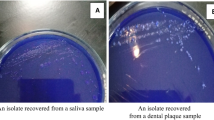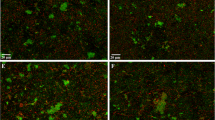Abstract
The antimicrobial effects and biofilm formation inhibition of tea polyphenols (TPP) extracted from Korean green tea (Camellia sinensis L) were evaluated against 12 oral microorganisms. Effective antimicrobial activity against all microorganisms tested, including Lactobacillus spp. (Lactobacillus acidophilus and Lactobacillus plantarum), Streptococcus spp. (Streptococcus mutans, Streptococcus sanguis, Streptococcus sobrinus, Streptococcus mitis, and Streptococcus salivarius), Staphylococcus aureus, Neisseria meningitidis, Escherichia coli, Enterobacter cloacae, Enterococcus faecalis, and Candida albicans, was shown at 2,000 μg/mL TPP within 5 min of incubation. Scanning electron microscopy (SEM) analysis revealed various morphological changes, such as the presence of perforations, the formation of cell aggregates, and the leakage of cytoplasmic materials from cells treated with TPP, depending on the bacteria. The potential role of TPP in biofilm formation inhibition on human teeth was evaluated in BHI broth with 2 mixed strains of S. mutans and S. sanguis. SEM analysis showed biofilm formation on the surface of a tooth shaken only in saline solution, whereas almost no biofilm was observed on a tooth incubated in TPP solution. This result suggests that TPP is effective against adherent cells of S. mutans and S. sanguis. Thus, TPP would be useful for development as an antimicrobial agent against oral microorganisms, and has great potential for use in mouthwash solutions for the prevention and treatment of dental caries.
Similar content being viewed by others
References
Lowe, G. D. O. (2004) Dental disease, coronary heart disease and stroke, and inflammatory markers what are the associations and what do they mean? Circulation 109: 1076–1078.
Meurman, J. H., M. Sanz, and S. J. Janket (2004) Oral health, atherosclerosis, and cardiovascular disease. Crit. Rev. Oral Biol. Med. 15: 403–413.
Awano, S., K. Gohara, E. Kurihara, T. Ansai, and T. Takehara (2002) The relationship between the presence of periodontopathogenic bacteria in saliva and halitosis. Int. Dent. J. 52: 212–216.
Burton, J. P., C. N. Chilcott, and J. R. Tagg (2005) The rationale and potential for the reduction of oral malodour using Streptococcus salivarius probiotics. Oral Dis. 11: 29–31.
Kazor, C. E., P. M. Mitchell, A. M. Lee, L. N. Stokes, W. J. Loesche, F. E. Dewhirst, and B. J. Paster (2003) Diversity of bacterial populations on the tongue dorsa of patients with halitosis and healthy patients. J. Clin. Microbiol. 41: 558–563.
Krespi, Y. P., M. G. Shrime, and A. Kacker (2006) The relationship between oral malodor and volatile sulfur compound-producing bacteria. Otolaryngol. Head Neck Surg. 135: 671–676.
Loesche, W. J. and C. Kazor (2002) Microbiology and treatment of halitosis. Periodontol. 28: 256–279.
Nakano, K., H. Nemoto, R. Nomura, H. Inaba, H. Yoshioka, K. Taniguchi, A. Amano, and T. Ooshima (2009) Detection of oral bacteria in cardiovascular specimens. Oral Microbiol. Immunol. 24: 64–68.
Nemoto, H., K. Nakano, R. Nomura, and T. Ooshima (2008) Molecular characterization of Streptococcus mutans strains isolated from the heart valve of an infective endocarditis patient. J. Med. Microbiol. 57: 891–895.
Poveda-Roda, R., Y. Jiménez, E. Carbonell, C. Gavaldá, M. M. Margaix-Muñoz, and G. Sarrión-Pérez (2008) Bacteremia originating in the oral cavity. Med. Oral Patol. Oral. Cir. Bucal. 13: 355–362.
Hirasawa, M., K. Takada, and S. Otake (2006) Inhibition of acid production on dental plaque bacteria by green tea catechins. Caries Res. 40: 265–270.
Sasaki, H., M. Matsumoto, T. Tanaka, M. Maeda, M. Nakai, S. Hamada, and T. Oshima (2003) Antibacterial activity of polyphenol compounds in oolong tea extract against Streptococcus mutans. Caries Res. 38: 2–8.
Yang, C. S. and J. M. Landau (2000) Effects of tea consumption on nutrition and health. J. Nutr. 130: 2409–2412.
Cowan, M. M. (1999) Plant products as antimicrobial agents. Clin. Microbiol. Rev. 12: 564–582.
Hamilton-Miller, J. M. T. (1995) Antimicrobial properties of tea (Camella sinensis L.). Antimicrob. Agents Chemother. 39: 2375–2377.
Yang, C. S., J. Hong, Z. Hou, and S. Sang (2004) Green tea polyphenols: antioxidative and prooxidative effects. J. Nutr. 134: 3181S.
Blanco, A. R., A. Sudano-Roccaro, G. C. Spoto, A. Nostro, and D. Rusciano (2005) Epigallocatechin gallate inhibits biofilm formation by ocular staphylococcal isolates. Antimicrob. Agents Chemother. 49: 4339–4343.
Cho, Y. S., N. L. Schiller, H. Y. Kahng, and K. H. Oh (2007) Cellular responses and proteomic analysis of Escherichia coli exposed to green tea polyphenols. Curr. Microbiol. 55: 501–506.
Cho, Y. S., N. L. Schiller, and K. H. Oh (2008) Antibacterial effects of green tea polyphenols on clinical isolates of methicillin-resistant Staphylococcus aureus. Curr. Microbiol. 57: 542–546.
De Man, J. C., M. Rogosa, and M. E. Sharpe (1960) A medium used for the cultivation of lactobacilli. J. Appl. Bacteriol. 23: 130–135.
Creitz, J. R. and T. F. Puckett (1954) A method for cultural identification of Coccidioides immitis. Am. J. Clin. Pathol. 24: 1318–1323.
Murray P. R., E. J. Baron, M. A. Pfaller, F. C. Tenover, and R. H. Yolken (1999) Manual of Clinical Microbiology. 7th ed. American Society for Microbiology, Washington, DC, USA.
Holt-Harris, J. E. and O. Teague (1916) A new culture medium for the isolation of Bacillus typhosa from stools. J. Infect. Dis. 18: 596.
Hoffmann, H., S. Stindl, W. Ludwig, A. Stumpf, A. Mehlen, J. Heesemann, D. Monget, K. H. Schleifer, and A. Roggenkamp (2005) Reassignment of Enterobacter dissolvens to Enterobacter cloacae as E. cloacae subspecies dissolvens comb. nov. and emended description of Enterobacter asburiae and Enterobacter kobei. Syst. Appl. Microbiol. 28: 196–205.
Xu, J. Z., S. Y. Yeung, Q. Chang, Y. Huang, and Z. Y. Chen (2004) Comparison of antioxidant activity and bioavailability of tea epicatechins with their epimers. Br. J. Nutr. 91: 873–881.
Ho, E. M., H. W. Chang, S. I. Kim, H. Y. Kahng, and K. H. Oh (2004) Analysis of TNT (2,4,6-trinitrotoluene)-inducible cellular responses and stress shock proteome in Stenotrophomonas sp. OK-5. Curr. Microbiol. 49: 346–352.
Ng, L. K., R. Sherburne, D. E. Taylor, and M. E. Stiles (1985) Morphological forms and viability of Campylobacter species studied by electron microscopy. J. Bacteriol. 164: 338–343.
Matsumoto, M., T. Minami, H. Sasaki, S. Sobue, and S. Hamada (1999) Inhibitory effects of oolong tea extract on caries-including properties of mutans streptococci. Caries Res. 33: 441–445.
Otake, S., M. Makimura, T. Kuroki, Y. Nishihara, and M. Hirasawa (1991) Anticaries effects of phenolic compounds from Japanese green tea. Caries Res. 25: 438–443.
Chang, H. W., H. Y. Kahng, S. I. Kim, J. W. Chun, and K. H. Oh (2004) Characterization of Pseudomonas sp. HK-6 cells responding to explosive RDX (hexahydro-1,3,5-trinitro-1,3,5-triazine). Appl. Microbiol. Biotechnol. 65: 323–329.
Author information
Authors and Affiliations
Corresponding author
Rights and permissions
About this article
Cite this article
Cho, YS., Oh, J.J. & Oh, KH. Antimicrobial activity and biofilm formation inhibition of green tea polyphenols on human teeth. Biotechnol Bioproc E 15, 359–364 (2010). https://doi.org/10.1007/s12257-009-0195-8
Received:
Revised:
Accepted:
Published:
Issue Date:
DOI: https://doi.org/10.1007/s12257-009-0195-8




